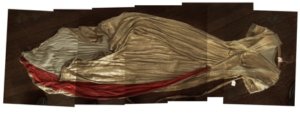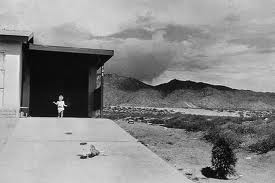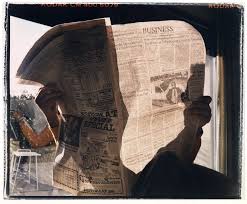
Pinstriped Suit for Rose, “Titanic,” 1997, by Deborah L. Scott
Just in time for Oscar buzz, your intrepid art blogger drove to Richmond, Virginia to scope out the century of film costumes now showing at the VMFA. This sweeping exhibition, organized by the Victoria and Albert Museum, London, includes cinema costumes from private and archival collections. First seen at the V&A and in Melbourne, Australia, the VMFA is the only East Coast venue to mount the show.
Costume has power. As you walk among this extraordinary clothing—made deliciously voyeuristic by the fact that echoing in your head throughout is Matt Damon actually wore those trousers! Marilyn Monroe’s skin touched that dress!—it’s more than the second-hand star power that inhabits the costumes, it’s the magical creation of someone new, not actor or actress, but a character we all believe really exists. We see these icons as not only the movie stars who played them, but as Travis Bickle, or Scarlett, or Sugar Kane, or Harry Potter. In the dressing room, we’re told, an actor makes “not so much a change of clothes, as a change of skin.”
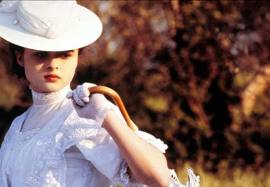
Lucy Honeychurch, from “A Room with a View,” 1985, by John Bright and Jenny Beavan
Look at Rose, “Titanic,” 1997, chic in purple pinstripes. In this costume, by Deborah L. Scott, 1997, she’s confident, if a bit demure, a well-bred young lady on an adventure. It’s all there.
Standing next to Rose is one of my all-time favorite characters, Lucy Honeychurch, played by Helena Bonham Carter in the 1985 production of “A Room with a View,” adapted from one of my all-time favorite novels by Henry James. This charmer, made of white cotton, linen, and lace is topped with saucy straw hat and accompanying parasol—a fresh young girl’s dress, perfect for the role.

Costume for “Atonement,” 2007, by Jacqueline Durran
Lounging nearby is the green vamp dress made for the Kiera Knightly character in “Atonement,” 2007, the acid counterpart to both Rose and Lucy. This secuctress was made “more naked,” by the use of laser cut patterns, according to Jacqueline Durran, its creator, allowing for a wide hem and more slippery movement.
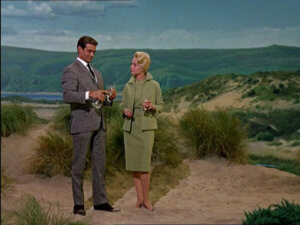
Tippi Hedren’s “Birds” costume, 1963, by Edith Head
Edith Head and Alfred Hitchcock carefully selected another green for the Melanie Daniels character in “The Birds,” 1963. Generally I’m not a fan of interactive, video-laden museum display, with its cacophonous babble of conflicting sound, but this show is the exception. Here Edith Head and Tippi Hedren discuss this celadon number, accompanied by clips from the movie, a reel of Kodak film, and a vintage poster. The cool green suit, one of only three costume changes in the film, is pure Edith Head—simple and elegant, the perfect embodiment of the icy Hitchcock princess headed for a fall—and a pecking.

Costume from “Elizabeth the Golden Age,” 2007, by Alexandra Byrne
Around the corner, one is met with a spectacular array of historic queens. My pick: Elizabeth the Golden Age,” 2007, by Alexandra Byrne for Cate Blanchett—damask, velvet, linen, and ostrich feathers. Fabulous! But the stiff corset stay underpinning can’t have been fun, even for slim Cate.
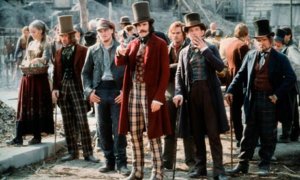
Costumes for “Gangs of New York,” 2002, by Sandy Powell
In another video interview, Martin Scorsese and Sandy Powell discuss how they came to create the fantastical costumes for “Gangs of New York,” 2002. Based upon a ton of research, the costumes are a blend of historical accuracy and pure fantasy. “Costume is character,” Scorsese says. Look at that hat on the Daniel Dey Lewis character, Billy the Butcher: it “cuts through the crowd” in an “imposing” fashion; the vibrant color, brocade vests, flamboyant neckties, all combine to create a hyper-vision of Five Points gangsters, where the intimidating bully meets the frock-coated dandy.

“Iron Lady,” 2012, costume by Consolata Boyle
Soon we’re in Meryl Streep and Robert De Niro land: her costumes from “Mama Mia,” “The Iron Lady,” “The French Lieutenant’s Wife,” and “Out of Africa;” his from “Taxi Driver,” “Raging Bull,” “King of Comedy,” and “Casino.” Telling details revealed: Meryl wanted to know what would have been in Margaret Thatcher’s purse and insisted exactly those things be there in the bag she carried in the film. Consolata Boyle’s costumes, along with Meryl’s acting chops, combine to eerily channel Margaret Thatcher on the screen.
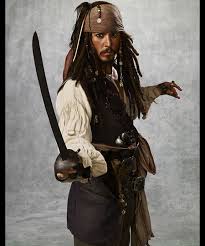
Jack Sparrow costume, 2011, by Penny Rose
I’m less a fan of “Gone with the Wind,” 1939, than many of you may be, so I won’t dwell long on the lace mantilla, or the “Paris hat” Rhett gives Scarlett, but they’re here, along with scripts and other memorabilia. I also won’t dwell for long in the macho room (“Action and Suspense”) where costumes from “Sherlock Homes, a Game of Shadows,” “Brokeback Mountain,” “Flash Gordon,” and other super-heroes are displayed. Still, the quintessential rock n’roller, Jack Sparrow (costume by Penny Lane for “Pirates of the Caribbean: on Stranger Tides,” 2011), does deserve an admiring pause. Depp based the character, famously, on Keith Richards, as he put it, “a bit of a rogue, slightly hopeless and threadbare.”

Louise Glaum in “Sex,” 1920
Linger I did in the “Femme Fatale” room—who wouldn’t? Surrounded by the vampiest costumes yet. For the 1920 film, boldly titled, “Sex” (yes, you can get it on Amazon), this number, with its blown glass bead cape designed for Louise Glaum, was the earliest costume to be screen-tested.
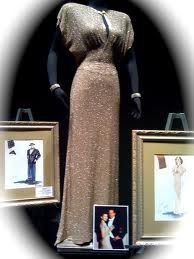
Gown for “Bugsy,” 1991, by Albert Wolsky
Next up, Annette Benning in “Bugsy,” 1991. Created by Albert Wolsky, this dress—see-through when backlit, remember?—used nine pounds of glittering silver beads. And who can forget that leg-crossing moment in “Basic Instinct,” 1992? Here we see Ellen Mirojnik’s stunning design for Sharon Stone. And if that doesn’t stop the show for you, take in Marlene Dietrich’s tuxedo, designed for the 1930 “Morocco” by Travis Bandon.

Sharon Stone in costume by Ellen Mirojnick for “Basic Instinct,” 1992
Should you go—the show is up until February 17, 2014, then it’s off to some undisclosed West Coast venue—do also take in “Made in Hollywood: Photographs from the John Kobol Foundation,” through March 10, a trove of 93 myth-making shots of Greta Garbo, Joan Crawford, Audrey Hepburn, Grace Kelly, which gives equal time to such hunks as Clark Gable, Marlon Brando, Rock Hudson, and Gary Cooper.
Bravo!
See more details here: http://www.vmfa.state.va.us/exhibitions/hollywood-costume.aspx?gclid=CND7_52Di7wCFYQ7OgodwXwAuQ


